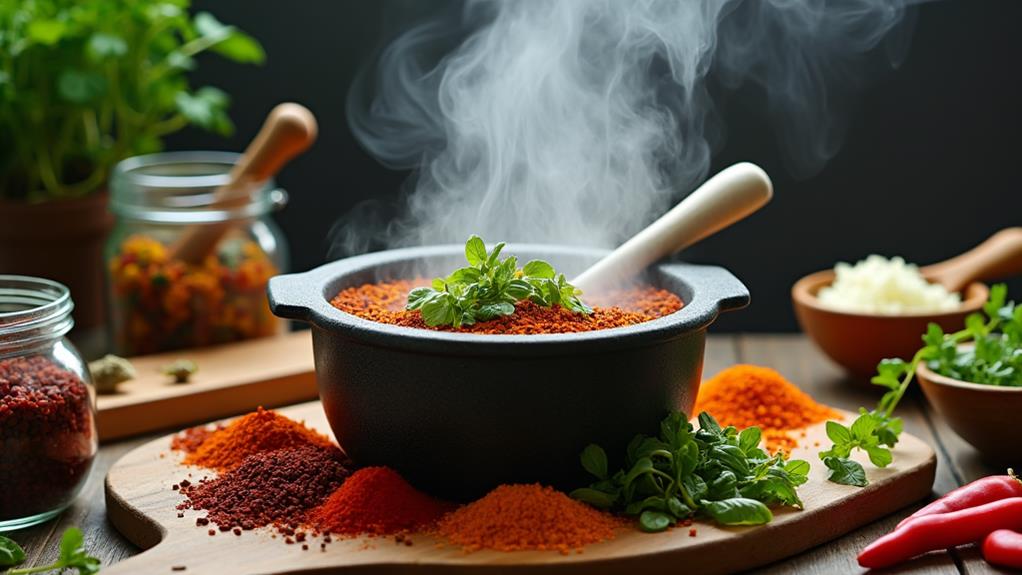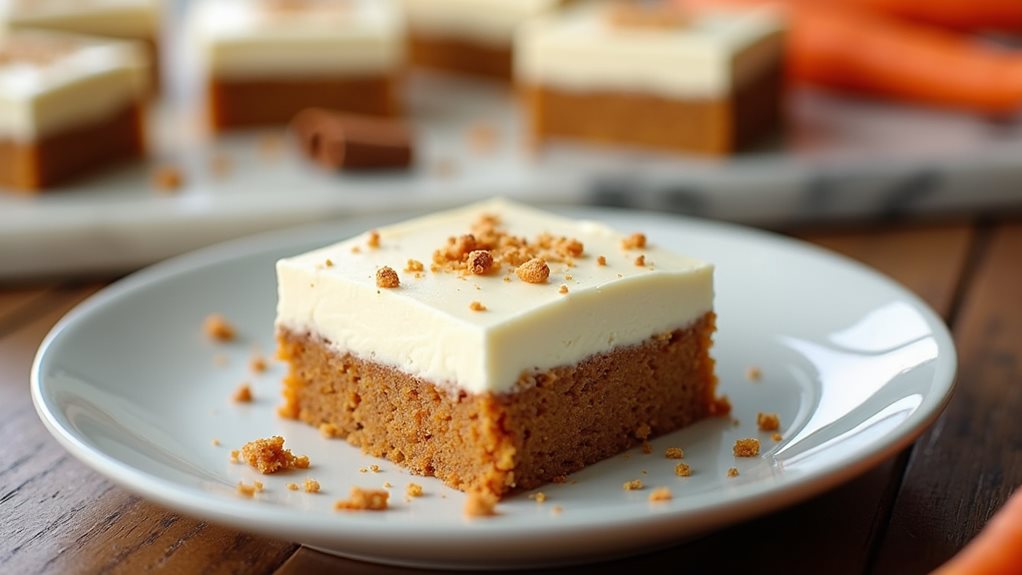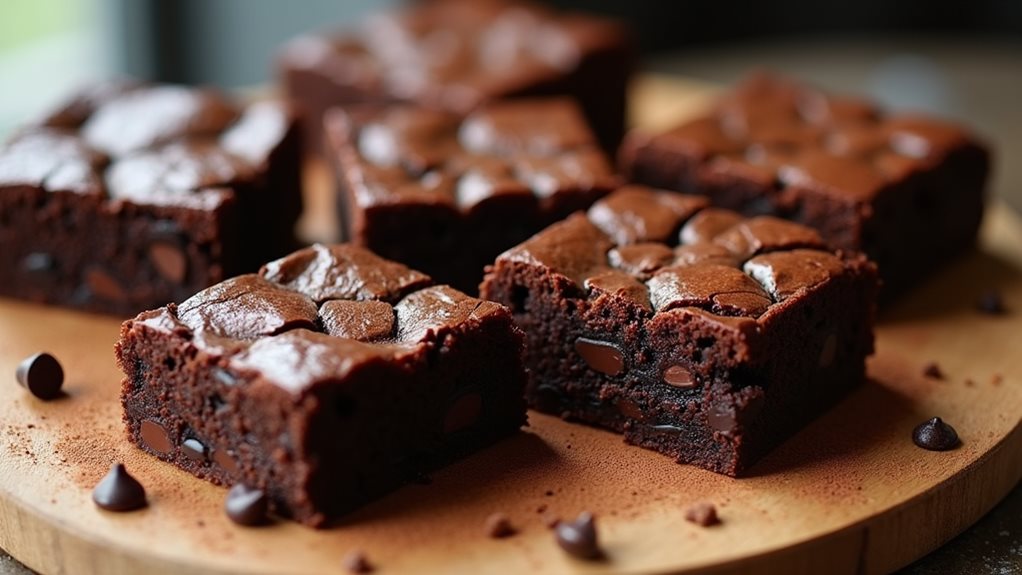To elevate your culinary game with herb and spice infusions, start by selecting high-quality ingredients and choosing an appropriate base like oil, vinegar, or alcohol. Prepare your infusion medium and introduce your chosen herbs and spices, considering their potency and compatibility. Monitor the process closely, adjusting infusion time based on desired flavor intensity. Strain the mixture and make final adjustments to achieve the perfect balance. When serving, pair your infusions with complementary dishes and use artistic garnishes for visual appeal. Experiment with unique combinations and presentation techniques to create tantalizing flavors that will impress your guests. The world of herb and spice infusions offers endless possibilities for culinary creativity.
Mastering the Art of Infusion
Through mastering the art of infusion, you'll unlock a world of flavors and aromas. Infusion techniques allow you to extract the essence of herbs and spices, transforming ordinary ingredients into extraordinary culinary creations. For instance, consider how herbs add depth to a dish like Herbed Quinoa Salad through their aromatic qualities.
To begin your journey, focus on understanding the science behind flavor extraction. Different methods yield varying results, so it's crucial to experiment and find what works best for your desired outcome.
Start by selecting high-quality herbs and spices, as their freshness directly impacts the intensity of the infusion. Consider using a variety of infusion mediums, such as oils, vinegars, or alcohols, each offering unique flavor profiles. Temperature plays a vital role in the process; cold infusions preserve delicate flavors, while hot infusions accelerate extraction.
Time is another critical factor, with longer infusions generally resulting in stronger flavors.
To innovate your culinary repertoire, try combining unexpected herbs and spices or infusing unconventional ingredients. Don't be afraid to push boundaries and create your own signature blends. By mastering these techniques, you'll elevate your cooking to new heights, impressing guests and satisfying your own culinary curiosity.
Selecting Fragrant Herbs and Spices
Countless fragrant herbs and spices await your selection, each offering unique aromatic profiles to enhance your infusions. When choosing your ingredients, consider their herb origins and spice varieties to create truly captivating blends.
Start by exploring classic herbs like basil, thyme, and rosemary, which hail from Mediterranean regions and offer robust, earthy flavors. For a more exotic touch, venture into Asian-inspired options such as lemongrass, kaffir lime leaves, or star anise. Incorporating herbs like watercress can also add a fresh peppery note to your dishes, similar to their role in dishes like Lentils With Spring Greens, enhancing the overall flavor profile.
Don't overlook the power of spices in your infusions. Cinnamon, cloves, and cardamom from tropical climates can add warmth and depth to your creations. Experiment with lesser-known spices like grains of paradise or long pepper to elevate your culinary game.
When selecting your herbs and spices, opt for fresh whenever possible, as they'll impart the most vibrant flavors. If using dried varieties, ensure they're still aromatic and haven't lost their potency.
Preparing the Base for Infusion
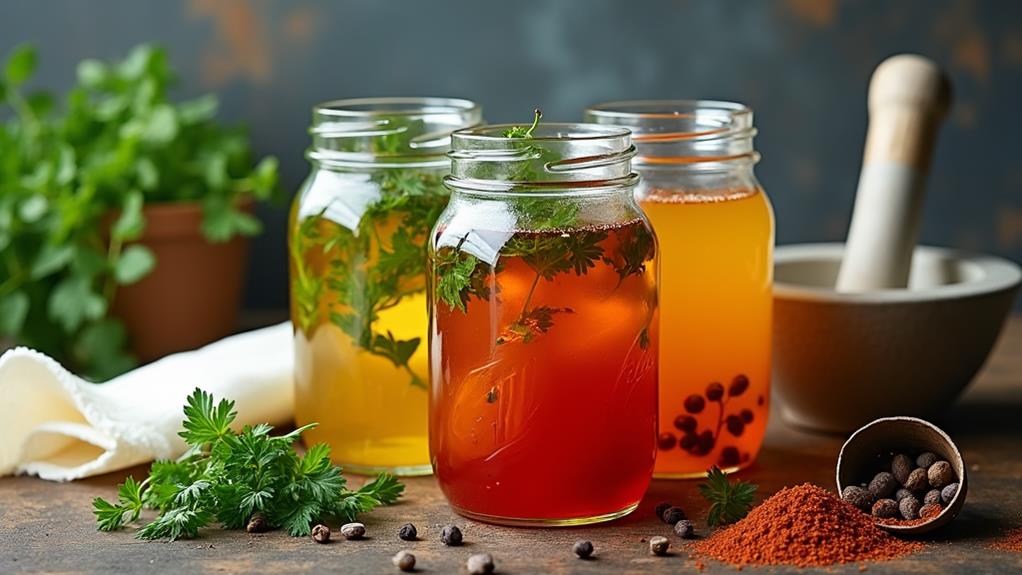
Before you begin infusing your chosen herbs and spices, you'll need to select an appropriate base for your infusion.
You'll want to choose a medium that complements the flavors you're working with, such as oil, alcohol, vinegar, or even honey.
Once you've selected your infusion base, it's crucial to properly sterilize all containers and tools you'll be using to ensure a clean and safe infusion process.
Choose Your Infusion Medium
The foundation of any successful herb or spice infusion lies in selecting the right medium. Your choice will significantly impact the flavor profile and versatility of your final product. For instance, an oil infusion can enhance dishes like a watermelon feta salad with a fragrant twist.
Consider these popular options:
- Oil infusions: Perfect for creating aromatic cooking oils or drizzles
- Alcohol infusions: Ideal for crafting unique cocktails or flavor-packed extracts
- Vinegar infusions: Excellent for adding zest to salad dressings and marinades
Don't limit yourself to these classics, though. Explore innovative mediums like honey infusions for a sweet twist, or dairy infusions to elevate your cream sauces.
Water infusions offer a lighter alternative, while broth infusions can add depth to your soups and stews. For tea enthusiasts, try infusing your favorite herbs directly into loose-leaf blends.
When selecting your medium, consider its compatibility with your chosen herbs or spices. Some delicate flavors may be overpowered by strong alcohols or vinegars, while others thrive in these bold bases.
Experiment with different combinations to discover unique flavor profiles that'll set your culinary creations apart. Remember, the medium you choose will serve as the canvas for your herbal masterpiece, so choose wisely and let your creativity shine.
Sterilize Containers and Tools
Proper sterilization of containers and tools is crucial for successful herb and spice infusions. To ensure your creations remain free from unwanted bacteria and contaminants, you'll need to focus on thorough container cleaning and tool maintenance.
Start by washing all your equipment with hot, soapy water, paying special attention to hard-to-reach areas. Rinse thoroughly and dry with a clean, lint-free cloth.
For glass containers, consider sterilizing them in boiling water for 10 minutes or using a diluted bleach solution. If you're using metal tools, sterilize them by submerging in boiling water for 5 minutes.
Plastic containers can be sanitized with a mixture of white vinegar and water. Always allow your equipment to air dry completely before use.
Don't forget about your workspace – wipe down surfaces with a food-safe disinfectant. Regularly inspect your tools for signs of wear or damage, replacing them as needed.
Introducing Herbs and Spices
Diving into the world of herbs and spices opens up a realm of endless culinary possibilities. As you embark on this flavorful journey, it's crucial to understand the rich spice history and herb benefits that have shaped cuisines worldwide.
Begin by selecting high-quality, fresh ingredients that will infuse your creations with robust flavors and aromas.
When introducing herbs and spices to your infusions, consider these key factors:
- Potency: Different herbs and spices have varying intensities, so adjust quantities accordingly.
- Compatibility: Choose combinations that complement each other and your base ingredient.
- Timing: Some herbs release flavors quickly, while others require longer infusion periods.
Experiment with classic pairings like rosemary and thyme for savory infusions, or cinnamon and star anise for sweet concoctions.
Don't hesitate to push boundaries by incorporating unexpected elements like lavender or saffron. As you refine your technique, you'll discover how to balance flavors and create unique profiles that elevate your culinary repertoire.
Monitoring the Infusion Process
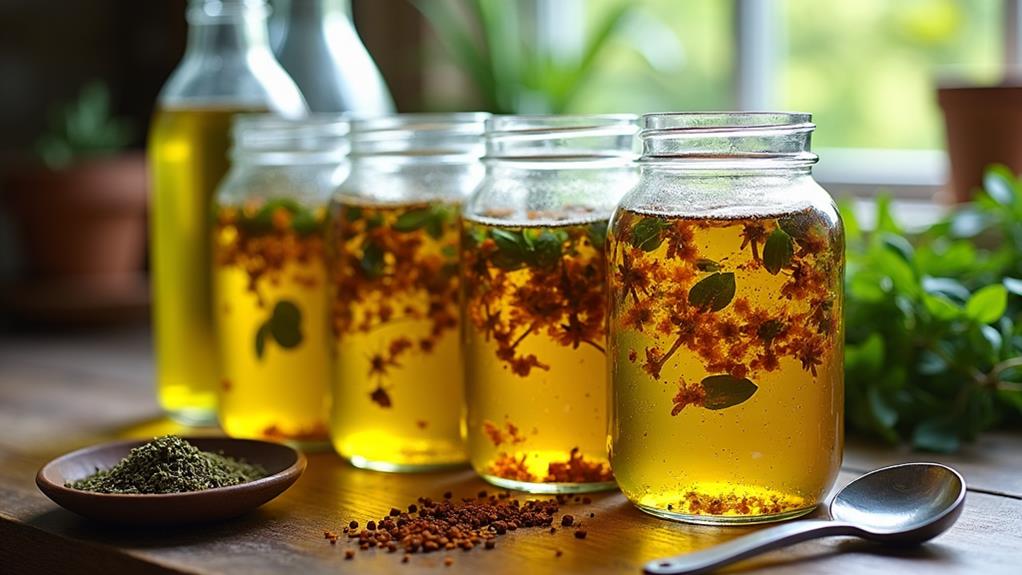
Throughout the infusion process, close monitoring is essential to achieve optimal flavor extraction and balance. You'll want to keep a watchful eye on infusion timing, as this directly impacts the intensity of flavors in your final product.
Start by setting a timer and checking your infusion every 15-30 minutes, depending on the herbs or spices you're using. As you taste-test, you'll notice the flavors developing and strengthening over time.
Pay attention to how the color and aroma of your infusion change, as these are key indicators of progress. If you're aiming for a bold flavor profile, you may need to extend the infusion time, while subtle notes might require a shorter duration.
Keep in mind that some herbs and spices release their flavors more quickly than others, so you'll need to adjust your approach accordingly. Don't be afraid to experiment with different combinations and infusion times to discover unique flavor profiles.
Finishing Touches
Three key steps will elevate your infused creation from good to exceptional. First, strain your infusion to remove any solid particles, ensuring a smooth and pure final product. Use a fine-mesh strainer or cheesecloth to catch even the smallest bits, preserving the clarity of your infusion.
Next, consider adjusting the flavor intensity. You can dilute the infusion if it's too strong or reduce it further if you desire a more concentrated taste.
Finally, add the finishing touches that will make your infusion truly shine.
To perfect your infusion techniques, focus on these final elements:
- Balance: Taste your creation and adjust sweetness, acidity, or spiciness as needed.
- Clarity: If desired, use a coffee filter for ultra-clear results.
- Presentation: Choose an attractive bottle or container that complements your infusion.
Serving Suggestions
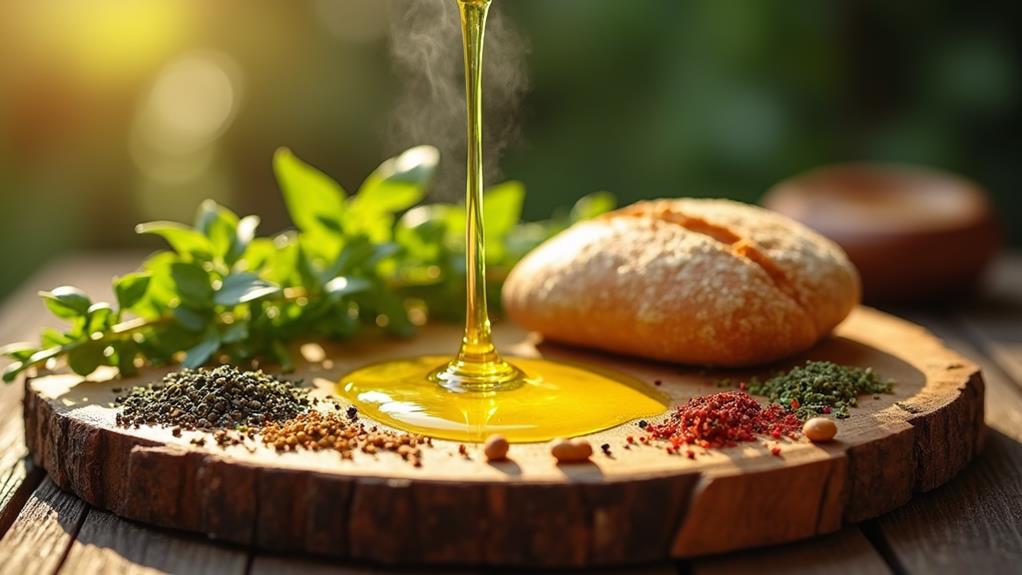
When serving your infused herbs and spices, you'll want to consider pairing them with dishes that complement their unique flavors.
You can elevate the presentation by garnishing with fresh herbs or a sprinkle of the infused spices, creating a visually appealing and aromatic dish.
Experiment with different flavor combinations, such as pairing citrus-infused herbs with seafood or spicy-infused spices with grilled meats, to discover exciting new taste experiences.
Pairing With Dishes
How can you elevate your culinary creations with herb and spice-infused oils? By pairing these flavorful concoctions with the right dishes, you'll transform ordinary meals into extraordinary experiences.
Consider the herb variations and spice origins when selecting your infusions, as they'll complement different cuisines in unique ways.
For maximum impact, try these pairings:
- Rosemary-infused olive oil drizzled over roasted potatoes or grilled lamb
- Garlic and chili-infused oil tossed with pasta or used as a bread dipping sauce
- Lemongrass and ginger-infused coconut oil brushed on grilled fish or shrimp
Don't limit yourself to traditional combinations. Experiment with unexpected pairings to create innovative flavor profiles.
For instance, use basil-infused oil in a fruit salad or drizzle star anise-infused oil over vanilla ice cream. The key is to balance the intensity of the infused oil with the dish's inherent flavors.
Start with small amounts and adjust to taste, allowing the infusion to enhance rather than overpower the meal.
Garnishing and Presentation
Presentation plays a crucial role in showcasing your herb and spice-infused oils. To elevate your culinary game, focus on garnish techniques that enhance visual appeal and complement flavors. Experiment with creative arrangements, using edible flowers, microgreens, or herb sprigs to add pops of color and texture variations.
Consider plating ideas that incorporate artistic drizzles or droplets of infused oil, creating eye-catching patterns on the dish.
Explore innovative presentation styles by utilizing unique serving vessels, such as small glass bottles, ceramic spoons, or even hollowed-out vegetables. These unconventional choices can spark conversation and intrigue your guests.
Pay attention to color contrasts when selecting your garnishes and plates, as this can dramatically impact the overall aesthetic. For example, pair a vibrant green basil-infused oil with a stark white plate for maximum impact.
Don't forget about finishing garnishes like flavored salts, crushed spices, or finely grated citrus zest, which can add both visual interest and an extra layer of flavor.
Complementary Flavor Combinations
After mastering the art of infusion and presentation, it's time to explore complementary flavor combinations that will elevate your culinary creations. Understanding herb profiles and spice compatibility is crucial for achieving taste balance and aroma enhancement in your dishes.
Consider the flavor intensity of each ingredient and how it interacts with others to create harmonious blends.
To innovate in your kitchen, explore these flavor pairing strategies:
- Combine herbs and spices from different culinary traditions to create unique fusion flavors
- Experiment with regional herbs and seasonal spices to add depth and authenticity to your dishes
- Balance strong flavors with milder ones to achieve a well-rounded taste profile
When selecting complementary flavors, consider the overall taste balance of your dish. Pair robust herbs like rosemary with earthy spices like cumin for a bold flavor profile.
Alternatively, combine delicate herbs such as basil with light spices like cardamom for a more subtle taste experience.
Remember that flavor intensity can vary depending on the cooking method and duration, so adjust your combinations accordingly.
Frequently Asked Questions
Can I Reuse Herbs and Spices After Infusion?
You can reuse infused herbs and spices, but their flavor intensity will be diminished. Get creative with infusion techniques to extract maximum flavor initially. Consider repurposing the used ingredients in stocks, marinades, or as aromatic garnishes.
How Long Can I Store Infused Oils and Vinegars?
You'll find infused oils and vinegars can last up to 6 months when refrigerated. For peak flavor intensity, consume within 1-2 months. Always check for signs of spoilage before use, and experiment with creative infusion combinations.
Are There Any Safety Concerns When Infusing With Fresh Herbs?
You'll be shocked by the dangers lurking in your fresh herbs! Don't panic, though. To avoid herb contamination, always wash them thoroughly. For ultimate fresh herb safety, consider blanching before infusing. It's a game-changing technique for innovative cooks!
Can I Use Dried Herbs Instead of Fresh for Infusions?
Yes, you can use dried herbs for infusions. They'll pack a punch with concentrated flavors, but watch out—their potency means you'll need less. Experiment with quantities to find the perfect balance for your innovative culinary creations.
What's the Best Way to Strain Infused Liquids?
You'll want to explore innovative straining techniques for your infused liquids. Try using fine-mesh sieves, cheesecloth, or specialized infusion tools. Experiment with layered straining methods to achieve clarity and remove even the tiniest particles from your concoctions.
Final Thoughts
You've now unlocked the secrets of herb and spice infusion, transforming you into a culinary wizard capable of creating flavors so intense they'll make your taste buds explode with joy. Armed with this knowledge, you'll dazzle dinner guests, leaving them speechless as they savor your impossibly delicious creations. Remember, practice makes perfect, so don't be afraid to experiment. Soon, you'll be crafting infusions so remarkable, they'll rival the greatest chefs in history. Your kitchen is now your flavor laboratory – go forth and conquer!

